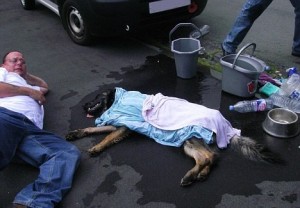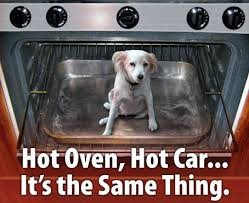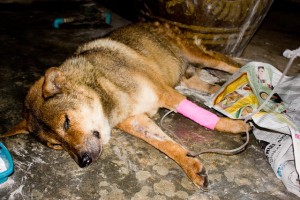Cats and Dogs don’t tolerate heat very well, because they don’t sweat like people do. They get rid of excess heat through panting and in a small degree through sweating through their foot pads.They can become overheated very easily if the environmental temperature is excessive, and certain conditions can make an animal more prone to heat stroke.
These risk factors are:
- Being a brachycephalic dog, with short noses and flat faces, such as Pugs, Pekinese, Boxers, Bulldogs, Shih Tzu’s, Boston Terriers etc.
- Being a very young pup or elderly pet, or obese
- Being left in a car on a hot day – this can be fatal in a relatively short time!
- Suffering from heart or lung disease (interferes with efficient breathing)
- Being confined without access to shade or water on a hot day
- Over exercising your dog or allowing your dog to over exercise in hot weather
Signs and Symptoms


The first signs of heat stroke in dogs include heavy panting and difficulty breathing. The tongue and gums will appear bright red and the eyes will glaze over. Vomiting and bloody diarrhea may be noticed and the dog becomes unsteady on his feet. There is excessive drooling. In the final stage seizures or loss of consciousness, and ultimately death may occur.
Cats can pant, have sweaty paws, groom excessively in an attempt to cool down, tongue and gums can also become red, vomiting and staggering and ultimately seizures or coma and death.
First Aid treatment
Move your pet out of the hot environment into a cooler area. Either into the shade or ideally into an air conditioned room.
Take his temperature rectally if possible. If the body temperature is above 40 degrees Celsius, active cooling down will need to be started by spraying him with cool (not icy cold) water, wet towels, and cool packs placed in the groin area. Putting a fan on him will help further cool him as well.
Continue to check the rectal temperature and stop the active cooling process once the temperature gets below 40 degrees Celsius as too much cooling can cause hypothermia and shock.
Call Cronulla Vet Clinic as soon as you can, to let us know you have a heat stroke case and will be coming in, as further complications can still occur, even if your pet seems better. If your pet is alert and able to stand and if you have checked with the vet, you can give small amounts of water. Never give large bowls of water at once in case vomiting makes things worse.
If your pet is not very alert, don’t give anything by mouth but visit our clinic immediately.
Prevention


Exercise your dog early in the morning, or later in the evening, on hot summer days. Try not to over-exercise your pet, even later in the evenings.
Keep your pet indoors during the heat of the day and have plenty of fresh clean water available. If it is not possible to keep your pet indoors, make sure to have access to plenty of complete shade, and fresh water.
Beware of hot concrete or pavers – the heat can burn your pet’s feet and rising heat can contribute to heat stroke in small animals.
Never leave your pet in a locked car, not even for a few minutes, not even with the windows down a bit!
Veterinary Treatments


Heat stroke victims are at risk of multiple organ damage. The excessive body heat causes cells to die, blood pressure to drop, dehydration and damage to heart, respiratory system, liver, kidneys, brain/central nervous system, gastrointestinal tract, blood clotting system etc.
The first aid of cooling down will continue as needed. Your vet may wish to do baseline bloods. An intravenous drip will be started for fluid support and electrolyte correction, and other medications such as stomach protectants, antibiotics, oxygen, brain protectants and intensive care nursing will be provided.
Blood clotting may remain abnormal for up to 2 weeks after discharge from hospital, so follow all veterinary instructions for aftercare and keep your pet cool and quiet for that period of time as well.
